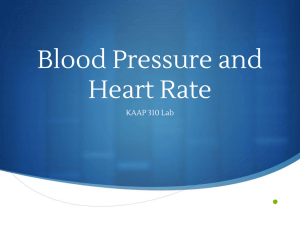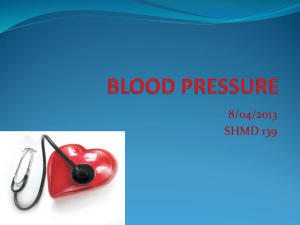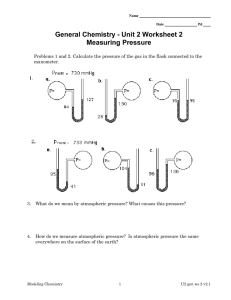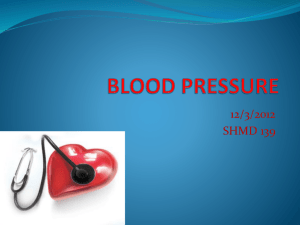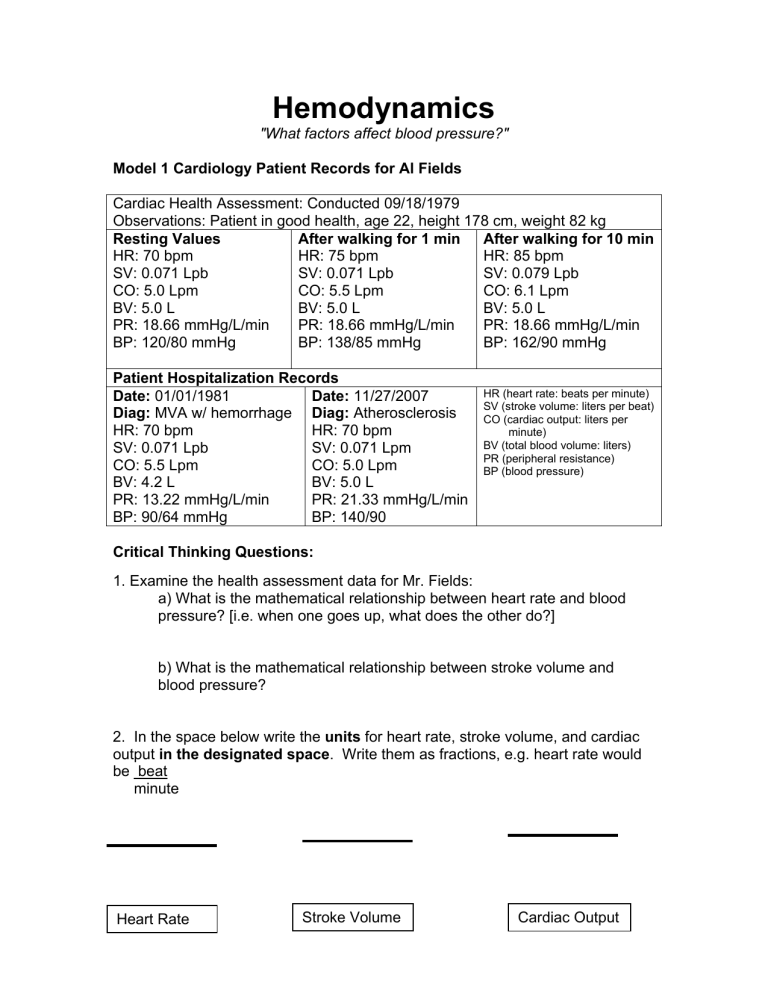
Hemodynamics "What factors affect blood pressure?" Model 1 Cardiology Patient Records for Al Fields Cardiac Health Assessment: Conducted 09/18/1979 Observations: Patient in good health, age 22, height 178 cm, weight 82 kg Resting Values After walking for 1 min After walking for 10 min HR: 70 bpm HR: 75 bpm HR: 85 bpm SV: 0.071 Lpb SV: 0.071 Lpb SV: 0.079 Lpb CO: 5.0 Lpm CO: 5.5 Lpm CO: 6.1 Lpm BV: 5.0 L BV: 5.0 L BV: 5.0 L PR: 18.66 mmHg/L/min PR: 18.66 mmHg/L/min PR: 18.66 mmHg/L/min BP: 120/80 mmHg BP: 138/85 mmHg BP: 162/90 mmHg Patient Hospitalization Records Date: 01/01/1981 Date: 11/27/2007 Diag: MVA w/ hemorrhage Diag: Atherosclerosis HR: 70 bpm HR: 70 bpm SV: 0.071 Lpb SV: 0.071 Lpm CO: 5.5 Lpm CO: 5.0 Lpm BV: 4.2 L BV: 5.0 L PR: 13.22 mmHg/L/min PR: 21.33 mmHg/L/min BP: 90/64 mmHg BP: 140/90 HR (heart rate: beats per minute) SV (stroke volume: liters per beat) CO (cardiac output: liters per minute) BV (total blood volume: liters) PR (peripheral resistance) BP (blood pressure) Critical Thinking Questions: 1. Examine the health assessment data for Mr. Fields: a) What is the mathematical relationship between heart rate and blood pressure? [i.e. when one goes up, what does the other do?] b) What is the mathematical relationship between stroke volume and blood pressure? 2. In the space below write the units for heart rate, stroke volume, and cardiac output in the designated space. Write them as fractions, e.g. heart rate would be beat minute Heart Rate Stroke Volume Cardiac Output Just looking at the fractions you’ve written on the previous page, insert mathematical operators (plus signs, multiplication signs, equals sign) into your units above so that you devise an equation that explains the relationship between heart rate, stroke volume, and cardiac output. i.e. make the units cancel out! 3. Write a consensus definition of cardiac output. Be able to explain your definition to the class. 4. What is the relationship between cardiac output and blood pressure? 5. There are three factors that influence blood pressure. We have established that cardiac output (which includes stroke volume and heart rate) is one. Based on the data, what are the other two? Application 6. When Al Fields was admitted in 1981, the first thing the ER team did was push 1 liter of IV buffered Ringer’s solution into his circulatory system. Why? 7. Atherosclerosis is the narrowing of the arteries due to build up of plaques on the artery walls. Explain why people with atherosclerosis have elevated blood pressure. Memorization fact: The best means of understanding total hemodynamics is the Mean Arterial Pressure (MAP). MAP is defined as diastolic pressure plus pulse pressure divide by three. Pulse pressure is the difference between the systolic and diastolic pressures. This can be expressed mathematically as: MAP = PD + (PS - PD) 3 Where PD is diastolic pressure and PS is systolic pressure. This particular measure of hemodynamics is holistic because MAP is equal to the product of cardiac output and peripheral resistance (MAP = CO X PR), so it takes into account all of the factors that can influence blood pressure. Model 2 Arteries of the lower limb Femoral Artery: length: 33 cm diameter: 4.5 mm PR: 12 mmHg/L/min Deep Femoral Artery: length: 31.5 cm diameter: 1.5 mm PR: 16 mmHg/L/min Popliteal Artery: length: 14 cm diameter: 4.2 mm PR: 10 mmHg/L/min Critical Thinking Questions 8. What is the main morphological difference between the femoral artery and the deep femoral artery, length or diameter? a. Which has the higher peripheral resistance? 9. What is the main morphological difference between the Femoral artery and the Popliteal artery? a. Which has the higher peripheral resistance? 10. What does your group think is the relationship between artery length, diameter, and peripheral resistance? 11. Is there a physiological mechanism that can adjust artery length significantly in order to maintain homeostatic blood pressure? a) Explain why vasodilation and vasoconstriction of the arteries (specifically arterioles) is the most effective means of maintaining blood pressure from minute to minute.[make sure you discuss other mechanisms and why they might not always be effective] Application 12. When a person donates blood plasma, the formed elements are returned to the body while the plasma is retained. If no extra fluids are added this will obviously cause a drop in blood volume. What effect if any will this have on blood viscosity? 13. How would this change in viscosity affect peripheral resistance? [hint: think about trying to pour ketchup versus pizza sauce out of the same size bottle] What effect would this have on blood pressure? Vocabulary (homework) – use your textbook and what you have learned today to define the following terms in your own words: Venous return Preload Afterload End systolic volume End diastolic volume Frank-Starling Law of the Heart Cardioinhibitor reflex Cardioaccelerator reflex Exercises (homework) 1. At rest, Juliet’s heart rate is 72 BPM and her CO is 5.0 LPM. When she sees Romeo her heart rate reaches 120 BPM and her CO is 15.0 LPM. What is her SV both before she sees Romeo and after? 2. Mr. T has a BP of 120/80 what is his mean arterial pressure (MAP)? Assuming his CO = 5 LPM, what is the total peripheral resistance of Mr. T’s arterioles? If Mr. T starts pitying fools and his peripheral resistance rises to 25 mmHg/L/min, what will his MAP be? 3. Using the equations for MAP calculate MAP two ways for each of the boxes in model 9A. Problem 4. Dr. Brown gets totally ripped over the summer and decides to try out for a triathlon. After taking some endurance and cardiology tests he gets the following results: Ventricular end systolic volume = 50 mL; ventricular end diastolic volume = 160 mL; HR = 140 BPM; and BP = 135/78. Calculate the following for Dr. Brown: SV, MAP, CO, PR.
